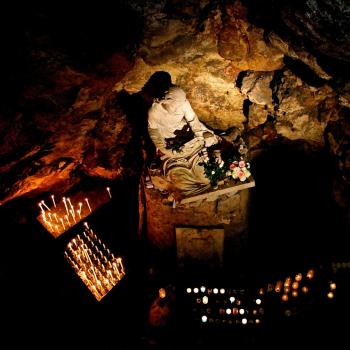
Christians use various methods, such as ascetic discipline, as a means for them to make for peace for themselves, and through that internal peace, they will be able to work for peace in the world. To work for peace is to work for restorative justice, to promote healing grace. Restorative justice is important because it produces the harmony necessary for lasting peace.
Peace is difficult, if not nearly impossible, to establish in the temporal world. There will be those who resist restorative justice and seek to disrupt the harmony which it is meant to bring. Accepting that things will not be perfect will allow us to hold honest expectations. We can do some good in the world and we should not stop pursuing it just because we cannot attain perfection. This is why we are told, “If possible, so far as it depends upon you, live peaceably with all” (Rom. 12:18 RSV). We should do what we can to make for as much peace as is possible in our lives, and not give in to despair because we will not experience any form of utopia during our temporal existence.
Ascetics realize that making peace with others means that they must look to their own lives, to see what they have done which works against the common good and the peace which flows from it and fix their mistakes. When they do this, they find miraculous things can and do happen. Indeed, such ascetics often find themselves at peace, not only with those men and women who they encounter on a daily basis, but with animals, and all living things on the face of the earth. This is why many saints are known to have special relationships with animals; they have found such peace within that they can and share the benefits of that peace with all creation. St. Seraphim of Sarov, St. Francis of Assisi, St. Anthony of Padua, St. Anthony of Egypt, St. Jerome, and so many others have stories told of them which relate the extraordinary relationship they had with animals. It is not just the saints we know, but also many of the saints we do not know, saints whose names have not been left to us, whose stories nonetheless are still being told, which show us the great path which we should all take. We find one such story told by St. John Moschos, concerning an old man he encountered at the monastery of Abba John the Eunuch:
When we were at the ninth mile-post from Alexandria, we visited the monastery of Abba John the Eunuch for benefit <of our souls>. There we found a very old man who had been at the monastery for about eighty years. He had more compassion than anybody we ever saw, not only for men, but also for animals. What did this elder do? No other work but this: he would rise early and feed all the dogs of the lavra. He would give flour to the small ants, grain to the bigger ones. He would dampen biscuits and throw them up on the roof-tops for the birds to eat. Living like this, he left nothing to the monastery <when he died>, neither door nor window nor spy-hole nor lamp nor table. In brief (not to say it all and make the story too long), he left nothing whatsoever of the world’s goods behind. Not even one hour did he ever possess books, money or clothing. He gave everything to those in need, investing his entire concern in those things which were to come. [1]
This unnamed man found a way to make himself at peace with others by giving of himself to others with a radical, self-giving love that had him not think of himself but of others. He had nothing left to give when he died because he had already given all he had to others, human and animal alike. Even insects, such as ants, received the benefit of his love. This allowed him to truly be at peace, both within himself, and with the world around him. He kept the wisdom of the proverb to heart: “A righteous man has regard for the life of his beast, but the mercy of the wicked is cruel” (Prov. 12:10 RSV). He was never cruel. He made sure all forms of live had their value affirmed and in this way he truly became righteous and a marvel for us all. While we do not know his name, we know him by his deeds. We know him as a true representation of the kind of peace which can be had within the world when we give up all self-seeking and live out our lives as one continuous act of love. This is not to say everyone is called to such extremes as he. We can live out our lives like him, following the extremes he did, but have no love, and if we did so, we would find no peace, but on the other hand, we could live our life filled with love, and do so in another manner than he, and through that love find peace. What is important is to recognize the relationship between love, justice, grace, and peace, and how we must bring them all together in order to be holy. We are to find a way to truly bring peace to ourselves and through ourselves, to our interaction with all others, no matter what form those others take. Sadly, this sensibility, common in ancient Christianity, is not so common in modern time. This means Christians have ignored their proper place in the world. They no longer see themselves as being stewards over creation, sharing the grace which they have been given to the rest of the world. Instead of caring for the world and all that is within it, Christians now thing the world as an object to exploit, and in doing so, they reinforce a way of life which runs contrary to the self-giving love which they are meant to live out; is it no wonder, then, that the world is in such a bad shape, since Christians have lost their way?
Yet in the last several hundred years Christianity has been hesitant, at times, to include animals in either its ethical or its theological systems. Without addressing the issue of “the animal,” Christianity not only lives in a potentially dangerous bubble, but it risks becoming increasingly narcissistic and marginal to the world as we know it, and as we are making it. [2]
Instead of seeing nature, and the animal world within it, as something to exploit, we must once again acknowledge our place in the world is meant to be one of mediators, working to raise the world up through the grace which we have been given. We must recognize, as many of the saints did, that animals have a value of their own, one which we should respect:
Animals are not our property or chattel, therefore, but our peers and fellow travelers. Like us, they have their own likes and dislikes, fears and fixations. They have plans and purposes as important to them as our plans are to us. Animals not only have biologies; they also have biographies. [3]
In various lives of the saints, we find saints befriending animals, and in doing so, we learn a little of the biographies of those animals, showing the truth of what Kowalski wrote. Thus, in the life of St Francis of Assisi, who cannot see love that St. Francis had for the Wolf of Gubbio, and the friendship which the wolf developed, not only with Francis, but with the villagers who took it in? Who, upon reading about the life of St. Seraphim of Sarov, cannot see the close bond St. Seraphim of Sarov had with the bear, Misha? They could not speak with and make deals with animals if animals did not have souls and destinies of their own. But once we recognize this, we must realize that animals have a value all their own, one which is not had merely by their relationship with humanity:
The first concerns the spiritual status of animals. That animals are subjects of a soul in the sense of being recipients of a God-given life is hardly controversial within Judaism. Without endorsing any of the complex theories of metempsychosis, it is clear from the biblical literature that animals have the ‘breath of life’ within them. This single insight is sufficient basis to challenge many of the contemporary, still largely instrumentalist or reductionist, ideas of animals as things, commodities, or resources just for us. Whatever precise value other creatures have cannot be judged by their relationship to humankind alone.[4]
The value various creature have cannot be judged by their relations to us alone, but it should include it, and in doing so, we should see that the relationship which exists between humanity and animals means we have an obligation to take care of and protect them. To do otherwise is to reject the duty which God gave to us, the duty to take care of the earth and all that is on it. We might not know and understand their inner spiritual life, but we don’t have to in order to see that they have one which should be affirmed by us. Nonetheless, as some saints show is, it is possible for some to discern at least a little of the spiritual nature and spiritual life of such animals, and it was this discernment which moved them to have a special relationship with animals. They found a way to communicate with animals. Even if the vast differences between each and every kind of animal and us means such understanding will only be partial, that some level of communication, indeed, communion can be had between animals and some humanity should be enough to confirm animals have a life and personal all their own, that they have their own wants and desires. Even if their interests and way of life is conditioned in part by their nature, ours is as well, and as we know ours is not limited by such conditioning, we should be able to see that theirs is not either. If we realize this, then we should realize our work for peace in the world, though it starts within, includes not just our fellow humanity, but every living thing on the earth.
[1] St. John Moschos, The Spiritual Meadow. Trans. Jon Wortley (Collegeville, MN: Cistercian Publications, 1992; repr. 2008), 153 [#184].
[2] Laura Hobgood-Oster, The Friends We Keep: Unleashing Christianity’s Compassion for Animals (Waco, Texas: Baylor University Press, 2010), 6.
[3] Gary Kowalski, The Souls of Animals (Walpole, NH: Stillpoint Publications, 1991), 107.
[4] Andrew Linzey and Dan Cohn-Sherbok, After Noah: Animals and the Liberation of Theology (Herndon, VA: Mowbray, 1997), 58.
Stay in touch! Like A Little Bit of Nothing on Facebook.
If you liked what you read, please consider sharing it with your friends and family!

















